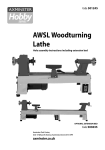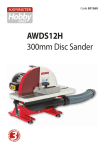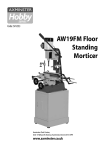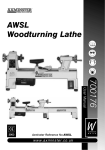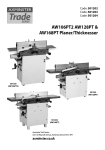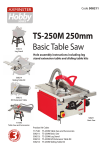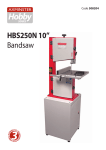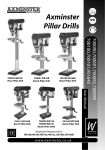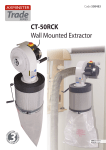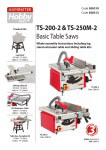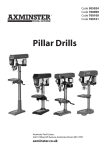Download Axminster AWDE5002 Instruction manual
Transcript
Code 501262 AWDE5002 Dust Extractor Axminster Tool Centre, Unit 10 Weycroft Avenue, Axminster, Devon EX13 5PH axminster.co.uk Index of Contents Page No Index of Contents Declaration of Conformity What’s in the Box General Instructions for 230V Machines Specific Safety for Dust Extractors Specification Assembly Identification and Parts Description Illustration and Parts Description Routine Maintenance Parts Breakdown Parts List Notes 02 02 03 04 05 06 07 08 09-10-11 12 13 14 15 Declaration of Conformity Copied from CE Certificate The undersigned, P. Seidel authorised by Laizhou Planet Machinery Co., Ltd 989 North Lai Zhou Road Laizhou, Shandong 261400 P.R. China declares that this product Model number FM230 Dust Collector manufactured by Laizhou Planet Machinery Co. is in compliance with the following standards or standardisation documents in accordance with Council Directives EN 55014-1 :2000+A1+A2 EN 61000-3-2 :2000+A2 EN 61000-3-3 :1995+A1 EN 55014-2 :1997+A1 Low Voltage Directive 73/23/EEC Amended by the Directive 93/68/EEC symbols below advise that you follow the correct Warning The safety procedures when using this machine. Fully read manual and safety instructions before use 02 Ear protection should be worn Eye protection should be worn Dust mask should be worn HAZARD Motor gets hot What’s in the Box Model Number: FM230 1 No. Dust Extractor, ready mounted on the base plate 1 No. Dust Bag 1 No. Handle 1 No. Outlet Duct and Gasket 1 No. Inlet Grill 2 No. Wall Mounting Brackets 1 No. Jubilee Clip 4 No. Castor Wheels 1 No. Instruction Manual 03 General Instructions for 230V Machines Good Working Practices/Safety The following suggestions will enable you to observe good working practices, keep yourself and fellow workers safe and maintain your tools and equipment in good working order. ! WARNING!! KEEP TOOLS AND EQUIPMENT OUT OF THE REACH OF YOUNG CHILDREN Mains Powered Tools and Machines Primary Precautions These machines are supplied with a moulded 13 Amp. Plug and 3 core power cable. Before using the machine inspect the cable and the plug to make sure that neither are damaged. If any damage is visible have the damaged item inspected/repaired by a suitably qualified person. If it is necessary to replace the plug, it is preferable to use an ‘unbreakable’ type that will most resist damage. Only use a 13 Amp plug, and make sure the cable clamp is tightened securely. Fuse as required.If extension leads are to be used, carry out the same safety checks on them, and ensure that they are correctly rated to safely supply the current that is required for your machine. Remember, most machines or tools have handles or holding positions, the power cable is not one of them. Work Place/Environment. The machine is not designed for use outside. Keep the machine clean; it will enable you to more easily see any damage that may have occurred. Clean the machine with a damp soapy cloth if needs be, do not use any solvents or cleaners, as these may cause damage to any plastic parts or to the electrical components. Keep the work area as uncluttered as is practical, this includes personnel as well as material. Under no circumstances should CHILDREN be allowed in work areas. ! It is good practice to leave the machine unplugged until work is about to commence, also make sure to unplug the machine when it is not in use, or 04 unattended. To avoid inadvertent ‘start up’; if your machine is not fitted with a NVR system, ensure the switch is always returned to the OFF position. Once you are ready to commence work, remove any tools, objects or items that could inadvertently get ‘sucked up’ by the machine (if any) and place safely out of the way. Re-connect the machine, ensuring the power cable is not ‘snagged’ or routed where it could be tripped over as you move about the workshop; it is not too close to an unguarded heat source, or is laid over or around a sharp edge. If the work you are carrying out is liable to generate flying grit, dust or chips, wear the appropriate safety clothing, goggles, gloves, masks etc. If the work operation appears to be excessively noisy, wear ear-defenders. If you wear your hair in a long style, wearing a cap, safety helmet, hairnet, even a sweatband, will minimise the possibility of your hair being caught up in the rotating parts of the machine, likewise, consideration should be given to the removal of rings and wristwatches if these are liable to be a ‘snag’ hazard. Consideration should also be given to non-slip footwear, etc. DO NOT work with cutting or boring tools of any description if you are tired, your attention is wandering or you are being subjected to distraction. A deep cut, a lost fingertip or worse; is not worth it! DO NOT use this machine within the designated safety areas of flammable liquid stores or in areas where there may be volatile gases. There are very expensive, very specialised machines for working in these areas, THIS IS NOT ONE OF THEM. Above all, OBSERVE…. make sure you know what is happening around you, and USE YOUR COMMON SENSE. Specific Safety for Dust Extractors DO NOT use this machine as a vacuum cleaner, try to keep the waste medium to wood by products. Do not uplift workshop floor debris (stones, nails, screws, paper etc., etc). Be aware that wood dust is an explosive medium. and a very firm feel means that the bag is clogged and the air is having difficulty passing through the cloth). DO NOT allow any ‘naked light’ source to occur anywhere near the machine. This includes cigarettes, matches, etc, and do not place the machine near any unprotected light bulbs, that could possibly get broken. The bag can be cleaned, but one of the simplest methods is to turn the bag inside out, and beat it as though it were a carpet. Similarly, empty the bag as often as possible (and is practical); as the bag fills up there is less free area of the bag to allow the air to flow through, again reducing the efficiency of the machine. The suction force is generated by a high speed fan unit. This has the potential to amputate fingers, grab loose clothing (ties etc.,) and ‘bat’ large chips etc, at high speeds. Keep all guarding in place, and if access to the fan becomes necessary (due to blockage etc.,) disconnect the machine from the mains supply and ensure the fan has come to a complete stop before putting your hands anywhere near to it. Be aware that in dry air periods or areas, the movement of the air through the machine can generate static electric fields. These are not normally a problem as the machine is bonded together via its construction, and the whole is earthed back through the electrical supply; problems can occur with isolated items, such as stands or hosing that are insulated from the ground (standing on rubber feet?, suspended in the air? etc). If you are not using ‘clear’ extraction hose, periodically remove the hose to check that the inlet to the machine is not getting restricted. (The safety guard grill of the inlet duct can be particularly irksome in this way, as long strand shavings etc., can wrap around the grill fret.) Keep the dust bag clean. The machine relies on its ability to ‘blow’ air through the dust bag, to generate good suction. If the cloth of the bag starts to clog, this reduces the air flow and hence the machine becomes less efficient. (A good indicator is the speed at which the bag inflates and how firm it feels; quick inflation If possible, try to connect everything together electrically, to eliminate static shocks. ! NOTE!! (Use the integral metal coil in flexible plastic hosing to connect units together) Try to route the power cable and the hosing away from busy walkways. DO NOT allow the inlet to become ‘dead ended’, or block or restrict the outlet, this puts undue work on the motor and can lead to overheating. DO NOT FIT PLASTIC WASTE BAGS TO THIS MACHINE 05 Specification Model Product Code Rating Power Air Flow Hose Diameter Bag Capacity Overall L x W x H Weight 06 AWDE5002 501262 Hobby 0.75kW (230V, 1ph) 840m³/hr @ 100mm 100mm 37 litres 380 x 1,100 x 410mm 22kg Assembly Please read through the Section entitled Identification and Description of Parts, this will enable you to more readily identify those parts of the machine to which we will be referring. Please Note that with the exception of the jubilee clip for attaching the dust bag; all the nuts, bolts, fasteners etc, for assembling the various components together are pre-positioned in the machine or the component. Having unpacked your AWDE5002 machine and all its components, please check against the ‘What’s in the box’ on page 4. If any parts are missing please contact our sales personnel straight away using the numbers listed in the catalogue. Having unpacked the machine and checked it over please dispose of any unwanted packaging in a responsible manner. Assembling the extractor. Place the base plate with the ready assembled fan housing and motor mounting onto the bench. Locate the handle, note that the fixing bolts washers etc., are already located in the handle. Offer the handle up to the rear face of the fan housing and introduce the bolts into the holes with the anchored nuts behind them. Tighten securely. Locate the outlet duct and its gasket. Remove the 6 off nut, bolt and washer sets from the component and using the same fastenings secure the duct and its gasket to the rectangular flange. Tighten securely. Later models have a separate inlet safety grill. Make sure this is fitted correctly. IT is suggested that the fitting of the dust bag is left until last, as it can get in the way during the following operations. The AWDE5002 as a movable appliance Locate the four off castor wheels. Locate their mounting positions on the base plate and remove the nuts, washers and screws. Fix the castors to the base plate using the forementioned fastenings and tighten securely. (See figs 2 & 2b) The AWDE5002 as fixed equipment Locate the wall mounting brackets and fasten to the wall, using wall plugs and screws. The position of the wall brackets need to be 172mm (centre to centre) with the ‘hook’ of the brackets at least 1100mm above the floor. See Fig 3 Fitting the Dust Bag Locate the jubilee clip and the dust bag. Push the opening of the dust bag through the jubilee clip and onto the outlet duct. Push the mouth of the bag as far as possible onto the duct. Slide the jubilee clip over the neck of the bag and fasten securely. Dust Extraction Hosing The hosing for this model is purchased separately. The hosing required is the 100mm diameter size. Fitting the hose is similar to fitting the dust bag, utilising a large jubilee or hose clip to hold the hose securely on the inlet duct. 07 Identification and Parts Description Base plate (See fig 2) Pressed steel plate that carries the fan unit and the motor bolted to it. It has numerous holes bored or cut into it, these are to mount the castor wheels (if you elect to make the machine movable) or the cutout slots for the wall mounting brackets if you elect to have it wall mounted. Fan housing (See fig 1) Mainly circular metal box with a rectangular outlet duct. The face of the box has a large circular access plate with the inlet duct extruded at its centre. This plate is bolted to the fan housing over a gasket to form a good seal. Motor (See fig 2) Single phase 230V 50Hz motor rated at 750W. The NVR assembly is fastened to the side of the motor casing. Handle (See fig 1) Bent steel tube with a rubber hand grip fitted over one end and flattened and bored at the other end to accept the two bolt fastenings that secure the handle to the back of the fan housing. Outlet duct (See fig 1b) Moulded 120mm diameter duct with integral grill to which the dust bag is fitted. The dust bag is held in position by a large jubilee clip. The duct is bolted to the fan housing over a rubber gasket to form as tight a seal as possible to prevent ‘air spillage’. Inlet duct (See fig 1) Formed 100mm diameter duct with integral grill on the front of the fan housing access cover plate. The connecting hose from the machine is positioned here and secured by jubilee clip et al. N.B. Later models have the inlet grill as a separate item, to enable easier access for cleaning. Wall mounting (See fig 3) The kit provides two formed metal brackets, that can be used to mount the extractor on a wall, clear of the floor. 08 Illustration and Parts Description Fig 1a Emergency stop NVR Switch Fig 1b Switch shroud Outlet duct Handle Dust bag Fig 1 Fan housing Inlet duct Access plate Base plate 09 Illustration and Parts Description Jubilee clip Handle Fig 2 Dust bag Emergency stop Switch shroud Power cable Motor Typ. 4 screws Base plate Fig 2a Fig 2b Cutout slots for the wall mounting brackets 10 Typ. 4 Castor wheels Illustration and Parts Description Fig 3 172mm Wall mounting bracket 1100mm 100mm hosing 11 Routine Maintenance ! DISCONNECT THE MACHINE FROM THE MAINS SUPPLY Weekly •Check the inlet and outlet ducts, remove any accumulated debris. •Check the inlet hoses for splits and cracks, repair as necessary. •Check the bag for wear and tear, especially around the neck at the jubilee clip. If wear or fraying is occurring, move the position of the jubilee clip slightly. •Check the motor for dust, sawdust, shavings etc, build up. If this has occurred, blow out with L.P. air or clean with a vacuum cleaner. (If ‘blowing out’ remember to wear eye protection and dependent on the type of dust, consideration should be given to face masking). Monthly •Carry out the weekly checks. •Dependent on usage consider ‘beating’ the bag to effect de-clogging. 12 Parts Breakdown 13 Parts List 14 Notes 15 Please dispose of packaging for the product in a responsible manner. It is suitable for recycling. Help to protect the environment, take the packaging to the local recycling centre and place into the appropriate recycling bin. Only for EU countries Do not dispose of electric tools together with household waste material. In observance of European Directive 2002/96/EC on waste electrical and electronic equipment and its implementation in accordance with national law, electric tools that have reached the end of their life must be collected separately and returned to an environmentally compatible recycling facility.
















